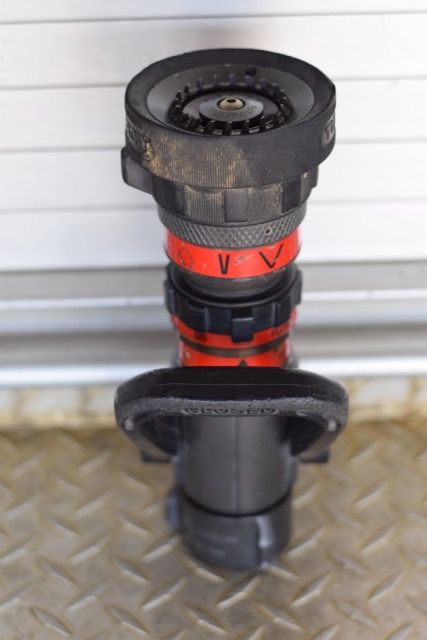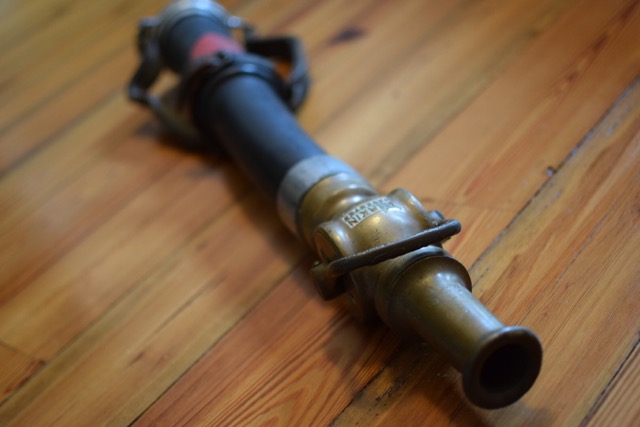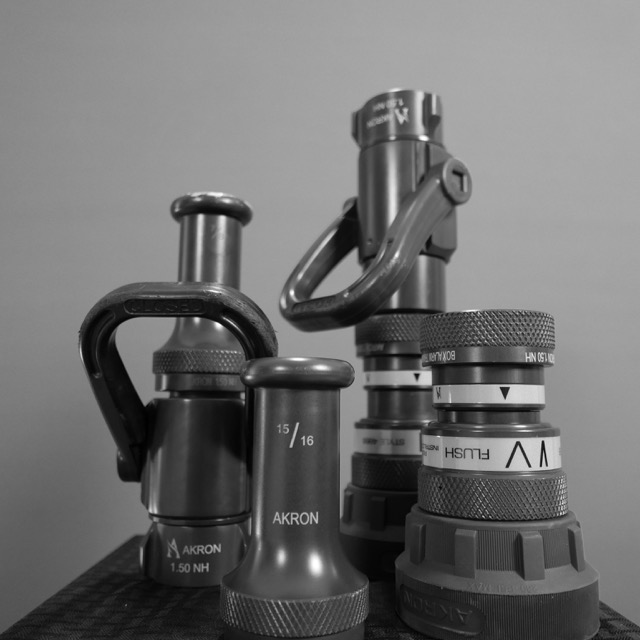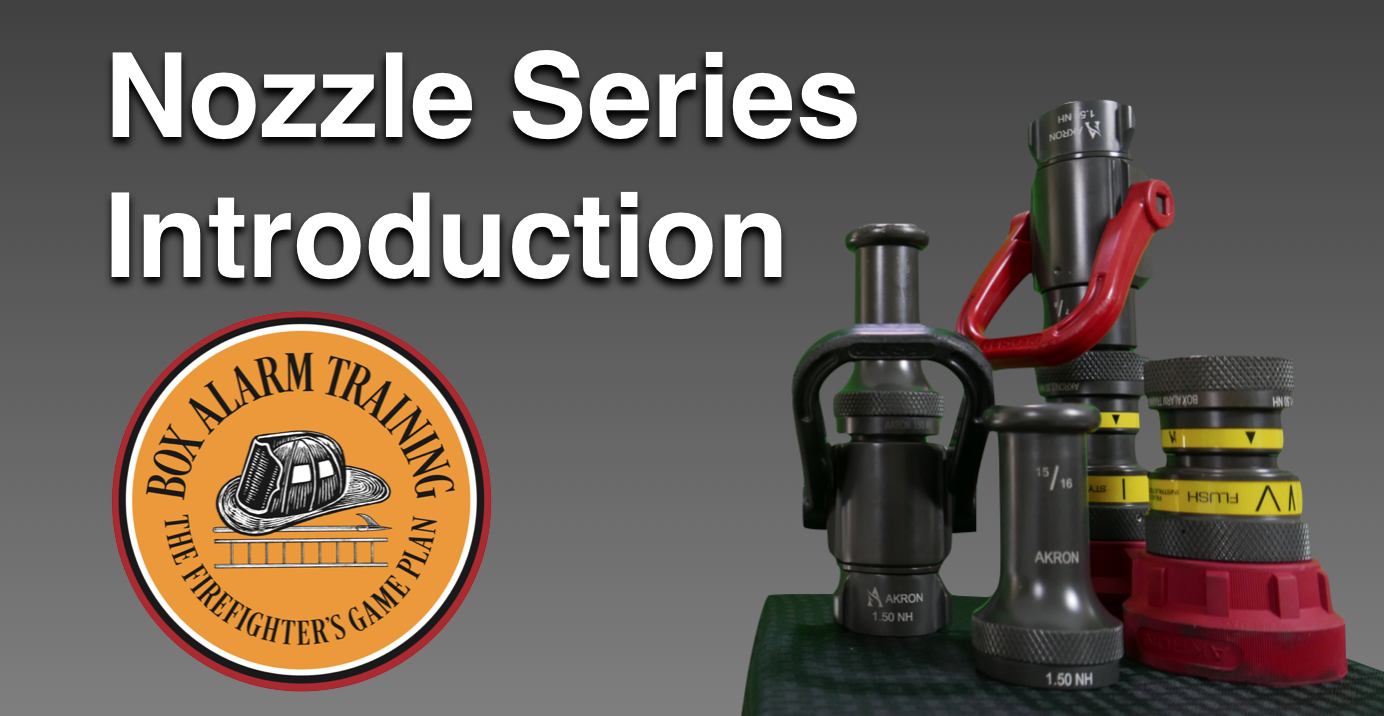 We are continuing our Nozzle Series with Automatic Nozzles. The Automatic Nozzle was originally designed on a napkin and since then has been widely used throughout the country. The goal of the automatic nozzle is to provide relatively consistent nozzle pressure throughout a wide range of flows. So, you will see automatic nozzles used in many different applications including foam operations and standpipe operations. You need to thoroughly evaluate the use of an automatic nozzle in certain applications prior to using them. While the nozzle can offer several advantages like the ability to provide the pump operator with an in-line pressure regulator it can also conceal hidden flow issues because of the nozzles abilities to maintain good nozzle pressure. Adequate nozzle pressure does not necessarily equate to adequate nozzle flow. When a hose line is kinked or something happens to inhibit the amount of water moving through the line you will see no major indications on the nozzle except for a drop in nozzle reaction. You need to get out and flow these nozzles to feel the difference in adequate flow and poor flow. Check out the video below for an overview of the Automatic Nozzle:
https://www.youtube.com/watch?v=pzYmWeUPruk
We are continuing our Nozzle Series with Automatic Nozzles. The Automatic Nozzle was originally designed on a napkin and since then has been widely used throughout the country. The goal of the automatic nozzle is to provide relatively consistent nozzle pressure throughout a wide range of flows. So, you will see automatic nozzles used in many different applications including foam operations and standpipe operations. You need to thoroughly evaluate the use of an automatic nozzle in certain applications prior to using them. While the nozzle can offer several advantages like the ability to provide the pump operator with an in-line pressure regulator it can also conceal hidden flow issues because of the nozzles abilities to maintain good nozzle pressure. Adequate nozzle pressure does not necessarily equate to adequate nozzle flow. When a hose line is kinked or something happens to inhibit the amount of water moving through the line you will see no major indications on the nozzle except for a drop in nozzle reaction. You need to get out and flow these nozzles to feel the difference in adequate flow and poor flow. Check out the video below for an overview of the Automatic Nozzle:
https://www.youtube.com/watch?v=pzYmWeUPruk
Nozzle Series - Adjustable Fog Nozzles
 The adjustable fog nozzle is a very popular type of nozzle seen on many apparatus. You will see this type of nozzle used in a wide variety of applications. The adjustable gallonage nozzle offers a lot of versatility because of it's ability to not only change patterns but also to increase and decrease the flow through the nozzle. However, it is very important for firefighters to understand that turning the gallonage adjustment does not necessarily equate to flowing what the actual setting is showing. As you turn the gallonage adjustment on this type of nozzle you are essentially making the orifice larger or smaller and as this adjustment is made the pump operator must compensate on the pump panel to deliver the appropriate nozzle pressure in order to flow the selected gallonage. This nozzle can offer advantages and disadvantages including the flexibility of adjusting the flow but disadvantages like the potential for accidental flow decrease if you bump the gallonage adjustment in the dark or smoke. Take a look at the video below covering Adjustable Gallonage Fog Nozzles:
The adjustable fog nozzle is a very popular type of nozzle seen on many apparatus. You will see this type of nozzle used in a wide variety of applications. The adjustable gallonage nozzle offers a lot of versatility because of it's ability to not only change patterns but also to increase and decrease the flow through the nozzle. However, it is very important for firefighters to understand that turning the gallonage adjustment does not necessarily equate to flowing what the actual setting is showing. As you turn the gallonage adjustment on this type of nozzle you are essentially making the orifice larger or smaller and as this adjustment is made the pump operator must compensate on the pump panel to deliver the appropriate nozzle pressure in order to flow the selected gallonage. This nozzle can offer advantages and disadvantages including the flexibility of adjusting the flow but disadvantages like the potential for accidental flow decrease if you bump the gallonage adjustment in the dark or smoke. Take a look at the video below covering Adjustable Gallonage Fog Nozzles:
https://www.youtube.com/watch?v=vS3m5B8Bh9E
Nozzle Series - Fixed Flow Fog Nozzles
 Fixed flow fog nozzles are a very popular type of nozzle seen all over the country. The nozzle offers several advantages including an adjustable pattern and simplicity of pump operations. You can find fixed flow fog nozzles in several different configurations. You will commonly see this type of nozzle offered in there different pressures; 100 psi, 75 psi and 50 psi. You will also see this type of nozzle offered in a breakaway version which is fairly popular for high-rise and hose packs. You will see many break away versions of this nozzle with a smoothbore integrated into the breakaway. Take a look at the video below for an overview of the Fixed Flow Fog Nozzle:
Fixed flow fog nozzles are a very popular type of nozzle seen all over the country. The nozzle offers several advantages including an adjustable pattern and simplicity of pump operations. You can find fixed flow fog nozzles in several different configurations. You will commonly see this type of nozzle offered in there different pressures; 100 psi, 75 psi and 50 psi. You will also see this type of nozzle offered in a breakaway version which is fairly popular for high-rise and hose packs. You will see many break away versions of this nozzle with a smoothbore integrated into the breakaway. Take a look at the video below for an overview of the Fixed Flow Fog Nozzle:
https://youtu.be/xfMI7rB-r9o
Nozzle Series - Smoothbores
The Smoothbore Nozzle
 We are continuing our video series on nozzles with the Smoothbore. This nozzle remains a powerhouse in the American Fire Service. With the increase in heat release rates due to changes in products and materials our ability to throw serious water on the fire is of the utmost importance. The smoothbore nozzle offers several advantages for firefighters. Some of strongest advantages come with the simplistic design of the nozzle. The smoothbore has the ability to perform under extreme conditions with good flow at a low nozzle reaction. The nozzle is very difficult to clog with debris and if a hose line becomes kinked it will maintain fairly good flow compared to a high pressure fog nozzle (100 psi). Even though the fog/combination nozzle has the ability to absorb more heat energy at the same flow, the smoothbore has the ability to penetrate without steaming off when attacking the fire. Once the stream enters the room on fire we can bounce the stream off of walls and ceilings to break up the stream and increase its heat absorption capabilities. The video below will provide you with an overview of the smoothbore nozzle and will cover a few topics in detail.
We are continuing our video series on nozzles with the Smoothbore. This nozzle remains a powerhouse in the American Fire Service. With the increase in heat release rates due to changes in products and materials our ability to throw serious water on the fire is of the utmost importance. The smoothbore nozzle offers several advantages for firefighters. Some of strongest advantages come with the simplistic design of the nozzle. The smoothbore has the ability to perform under extreme conditions with good flow at a low nozzle reaction. The nozzle is very difficult to clog with debris and if a hose line becomes kinked it will maintain fairly good flow compared to a high pressure fog nozzle (100 psi). Even though the fog/combination nozzle has the ability to absorb more heat energy at the same flow, the smoothbore has the ability to penetrate without steaming off when attacking the fire. Once the stream enters the room on fire we can bounce the stream off of walls and ceilings to break up the stream and increase its heat absorption capabilities. The video below will provide you with an overview of the smoothbore nozzle and will cover a few topics in detail.
https://www.youtube.com/watch?v=tgzHmYZ3BUo
Nozzle Video Series
Check out our newest firefighter training video series. We have produced a five part nozzle video series covering several common types of nozzles. In this first video we will provide an overview of nozzle types and discuss some of the advantages and disadvantages of the nozzles. In the coming videos we will be taking each nozzle type and discussing them in detail. https://www.youtube.com/watch?v=VVexyIWX2bI
This is My Nozzle
This is my nozzle. There are many like it but this one is mine.
 Many of you have heard the "Rifleman's Creed". A creed made famous by the United States Marine Corps. A creed that instills in Marines the sense of purpose and commitment to know your weapon and master it. As firefighters we should have the same sense of pride when identifying with our nozzle. In the truest sense it is all that stands between us and the fire."My nozzle, without me, is useless. Without my nozzle, I am useless."
Many of you have heard the "Rifleman's Creed". A creed made famous by the United States Marine Corps. A creed that instills in Marines the sense of purpose and commitment to know your weapon and master it. As firefighters we should have the same sense of pride when identifying with our nozzle. In the truest sense it is all that stands between us and the fire."My nozzle, without me, is useless. Without my nozzle, I am useless."
All too often, during training sessions or courses, I ask firefighters what type of nozzle they are using and they cannot tell me any specifics. If I posed the same question to a law enforcement officer about his weapon, he would most likely respond with not only the caliber of his weapon but also all of the ballistics associated with his weapon and the situations it is best suited for.
- "My nozzle and I know that what counts in war is not the water we flow, the noise of our bail, nor the pattern we make. We know that it is the hits that count. We will hit..."
 I am not asking for firefighters to simply tell me the make and model of their nozzle... I am asking them to tell me the characteristics of their nozzles; what is the reach and penetration of your nozzle, what does the nozzle reaction feel like, and what happens to your nozzle if it becomes clogged with debris?
I am not asking for firefighters to simply tell me the make and model of their nozzle... I am asking them to tell me the characteristics of their nozzles; what is the reach and penetration of your nozzle, what does the nozzle reaction feel like, and what happens to your nozzle if it becomes clogged with debris?
"I will learn its weaknesses, its strength, its parts, its accessories, its flow and its reach. I will keep my nozzle clean and ready, even as I am clean and ready. We will become part of each other. We will..."
We all know that your nozzle selection may not be entirely within your control but knowing your issued nozzle is just as important. I encourage you all to spend time learning your nozzles and teaching others how to properly use the nozzles. Learn the flows, learn the pressures and learn what the nozzle reaction feels like. Over the next month we will be releasing a nozzle video series on our YouTube channel going over nozzle types and their characteristics. Until then get out and flow some water!






